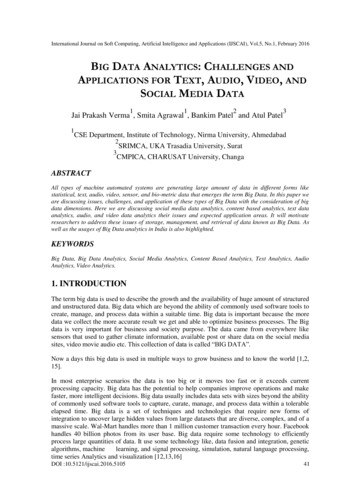
Transcription
http://poloclub.gatech.edu/cse6242CSE6242 / CX4242: Data & Visual AnalyticsScaling UpHBaseDuen Horng (Polo) ChauAssistant ProfessorAssociate Director, MS AnalyticsGeorgia TechPartly based on materials byProfessors Guy Lebanon, Jeffrey Heer, John Stasko, Christos Faloutsos, Parishit Ram (GT PhDalum; SkyTree), Alex Gray
What if you need real-timeread/write for large datasets?2
Lecture based on these two books.http://goo.gl/YNCWNhttp://goo.gl/svzTV3
http://hbase.apache.orgBuilt on top of HDFSSupports real-time read/write random accessScale to very large datasets, many machinesNot relational, does NOT support SQL(“NoSQL” “not only SQL”) http://en.wikipedia.org/wiki/NoSQLSupports billions of rows, millions of columns(e.g., serving Facebook’s Messaging Platform)Written in Java; works with other APIs/languages(REST, Thrift, Scala)Where does HBase come ache.org/hadoop/Hbase/PoweredBy4
HBase’s “history”Designed for batch processingHadoop & HDFS based on. 2003 Google File System (GFS) Ebooks/Misc/pdf/The%20Google%20filesystem.pdf 2004 Google MapReduce fHBase based on . 2006 Google Bigtable Designed for random access5
How does HBase work?Column-orientedColumn is the most basic unit (instead of row) Multiple columns form a row A column can have multiple versions, eachversion stored in a cellRows form a table Row key locates a row Rows sorted by row key lexicographically( alphabetically)6
Row key is uniqueThink of row key as the “index” of an HBase table You look up a row using its row keyOnly one “index” per table (via row key)HBase does not have built-in support for multipleindices; support enabled via extensions7
Rows sorted lexicographically( alphabetically)hbase(main):001:0 scan 'table1'ROWCOLUMN CELLrow-1column cf1:, timestamp 1297073325971row-10 column cf1:, timestamp 1297073337383row-11 column cf1:, timestamp 1297073340493row-2column cf1:, timestamp 1297073329851row-22 column cf1:, timestamp 1297073344482row-3column cf1:, timestamp 1297073333504row-abc column cf1:, timestamp 12970733498757 row(s) in 0.1100 seconds.“row-10” comes before “row-2”.How to fix?8
Rows sorted lexicographically( alphabetically)hbase(main):001:0 scan 'table1'ROWCOLUMN CELLrow-1column cf1:, timestamp 1297073325971row-10 column cf1:, timestamp 1297073337383row-11 column cf1:, timestamp 1297073340493row-2column cf1:, timestamp 1297073329851row-22 column cf1:, timestamp 1297073344482row-3column cf1:, timestamp 1297073333504row-abc column cf1:, timestamp 12970733498757 row(s) in 0.1100 seconds.“row-10” comes before “row-2”.How to fix?Pad “row-2” with a “0”.i.e., “row-02”8
Columns grouped into column families Why? Helps with organization, understanding, optimization, etc. In details. Columns in the same family stored in same file calledHFile inspired by Google’s SSTable large map whose keysare sorted Apply compression on the whole family .9
More on column family, columnColumn family An HBase table supports only few families (e.g., 10) Due to limitations in implementation Family name must be printable Should be defined when table is created Shouldn not be changed oftenEach column referenced as “family:qualifier” Can have millions of columns Values can be anything that’s arbitrarily long10
Cell ValueTimestamped Implicitly by system Or set explicitly by userLet you store multiple versions of a value values over timeValues stored in decreasing time order Most recent value can be read first11
Time-oriented view of a row12
Concise way to describe all these?HBase data model ( Bigtable’s model) Sparse, distributed, persistent, multidimensional map Indexed by row key column key timestamp(Table, RowKey, Family, Column, Timestamp) ! Value13
An exerciseHow would you use HBase to create a webtablestore snapshots of every webpage on theplanet, over time?14
Details: How does HBasescale up storage & balance load?Automatically divide contiguous ranges of rowsinto regionsStart with one region, split into two when gettingtoo large15
Details: How does HBasescale up storage & balance ling-really-works-in-apache-hbase/16
How to use HBaseInteractive shell Will show you an example, locally (on yourcomputer, without using HDFS)Programmatically e.g., via Java, Python, etc.17
Example, using interactive shellStart HBaseStart Interactive ShellCheck HBase is running18
Example: Create table, add values19
Example: Scan (show all cell values)20
Example: Get (look up a row)Can also look up a particular cell value, with acertain timestamp, etc.21
Example: Delete a value22
Example: Disable & drop table23
RDBMS vs HBaseRDBMS ( Relational Database Management System) MySQL, Oracle, SQLite, Teradata, etc. Really great for many applications Ensure strong data consistency, integrity Supports transactions (ACID guarantees) .24
RDBMS vs HBaseHow are they different? When to use what?25
RDBMS vs HBaseHow are they different? Hbase when you don’t know the structure/schema HBase supports sparse data (many columns, most values are notthere) Use RDBMS if you only work with a small number of columns Relational databases good for getting “whole” rows HBase: Multiple versions of data RDBMS support multiple indices, minimize duplications Generally a lot cheaper to deploy HBase, for same size of data(petabytes)26
More topics to learn aboutOther ways to get, put, delete. (e.g., programmatically via Java) Doing them in batchMaintaining your cluster Configurations, specs for “master” and “slaves”? Administrating cluster Monitoring cluster’s healthKey design (http://hbase.apache.org/book/rowkey.design.html) bad keys can decrease performanceIntegrating with MapReduceCassandra, MongoDB, b-vs-couchdb-vs-redis27
RDBMS vs HBase How are they different? Hbase when you don't know the structure/schema HBase supports sparse data (many columns, most values are not there) Use RDBMS if you only work with a small number of columns Relational databases good for getting "whole" rows HBase: Multiple versions of data










